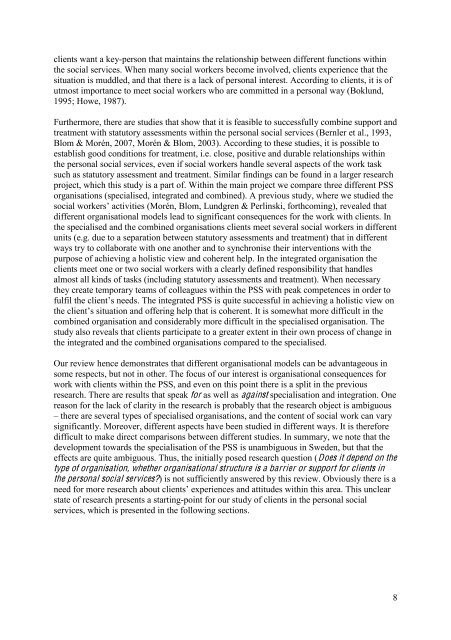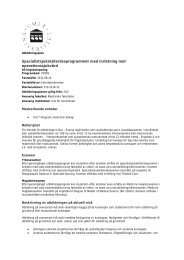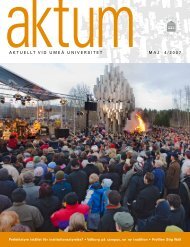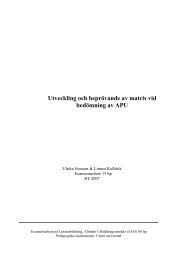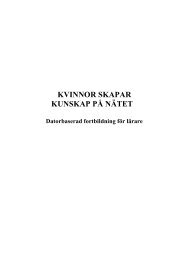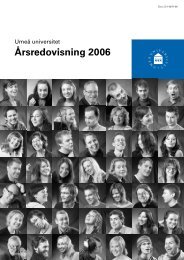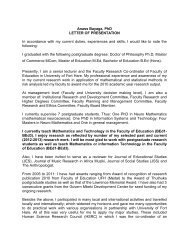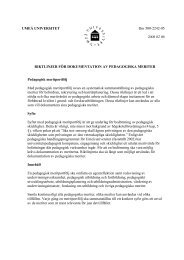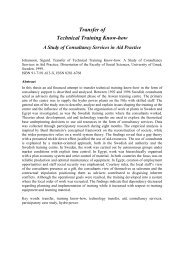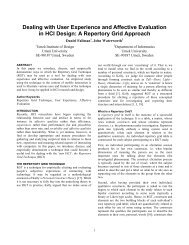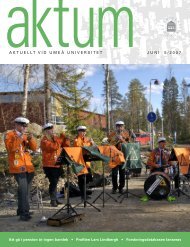Organisational Structure as Barrier or Support in the Personal Social ...
Organisational Structure as Barrier or Support in the Personal Social ...
Organisational Structure as Barrier or Support in the Personal Social ...
You also want an ePaper? Increase the reach of your titles
YUMPU automatically turns print PDFs into web optimized ePapers that Google loves.
clients want a key-person that ma<strong>in</strong>ta<strong>in</strong>s <strong>the</strong> relationship between different functions with<strong>in</strong><strong>the</strong> social services. When many social w<strong>or</strong>kers become <strong>in</strong>volved, clients experience that <strong>the</strong>situation is muddled, and that <strong>the</strong>re is a lack of personal <strong>in</strong>terest. Acc<strong>or</strong>d<strong>in</strong>g to clients, it is ofutmost imp<strong>or</strong>tance to meet social w<strong>or</strong>kers who are committed <strong>in</strong> a personal way (Boklund,1995; Howe, 1987).Fur<strong>the</strong>rm<strong>or</strong>e, <strong>the</strong>re are studies that show that it is fe<strong>as</strong>ible to successfully comb<strong>in</strong>e supp<strong>or</strong>t andtreatment with statut<strong>or</strong>y <strong>as</strong>sessments with<strong>in</strong> <strong>the</strong> personal social services (Bernler et al., 1993,Blom & M<strong>or</strong>én, 2007, M<strong>or</strong>én & Blom, 2003). Acc<strong>or</strong>d<strong>in</strong>g to <strong>the</strong>se studies, it is possible toestablish good conditions f<strong>or</strong> treatment, i.e. close, positive and durable relationships with<strong>in</strong><strong>the</strong> personal social services, even if social w<strong>or</strong>kers handle several <strong>as</strong>pects of <strong>the</strong> w<strong>or</strong>k t<strong>as</strong>ksuch <strong>as</strong> statut<strong>or</strong>y <strong>as</strong>sessment and treatment. Similar f<strong>in</strong>d<strong>in</strong>gs can be found <strong>in</strong> a larger researchproject, which this study is a part of. With<strong>in</strong> <strong>the</strong> ma<strong>in</strong> project we compare three different PSS<strong>or</strong>ganisations (specialised, <strong>in</strong>tegrated and comb<strong>in</strong>ed). A previous study, where we studied <strong>the</strong>social w<strong>or</strong>kers’ activities (M<strong>or</strong>én, Blom, Lundgren & Perl<strong>in</strong>ski, f<strong>or</strong>thcom<strong>in</strong>g), revealed thatdifferent <strong>or</strong>ganisational models lead to significant consequences f<strong>or</strong> <strong>the</strong> w<strong>or</strong>k with clients. In<strong>the</strong> specialised and <strong>the</strong> comb<strong>in</strong>ed <strong>or</strong>ganisations clients meet several social w<strong>or</strong>kers <strong>in</strong> differentunits (e.g. due to a separation between statut<strong>or</strong>y <strong>as</strong>sessments and treatment) that <strong>in</strong> differentways try to collab<strong>or</strong>ate with one ano<strong>the</strong>r and to synchronise <strong>the</strong>ir <strong>in</strong>terventions with <strong>the</strong>purpose of achiev<strong>in</strong>g a holistic view and coherent help. In <strong>the</strong> <strong>in</strong>tegrated <strong>or</strong>ganisation <strong>the</strong>clients meet one <strong>or</strong> two social w<strong>or</strong>kers with a clearly def<strong>in</strong>ed responsibility that handlesalmost all k<strong>in</strong>ds of t<strong>as</strong>ks (<strong>in</strong>clud<strong>in</strong>g statut<strong>or</strong>y <strong>as</strong>sessments and treatment). When necessary<strong>the</strong>y create temp<strong>or</strong>ary teams of colleagues with<strong>in</strong> <strong>the</strong> PSS with peak competences <strong>in</strong> <strong>or</strong>der tofulfil <strong>the</strong> client’s needs. The <strong>in</strong>tegrated PSS is quite successful <strong>in</strong> achiev<strong>in</strong>g a holistic view on<strong>the</strong> client’s situation and offer<strong>in</strong>g help that is coherent. It is somewhat m<strong>or</strong>e difficult <strong>in</strong> <strong>the</strong>comb<strong>in</strong>ed <strong>or</strong>ganisation and considerably m<strong>or</strong>e difficult <strong>in</strong> <strong>the</strong> specialised <strong>or</strong>ganisation. Thestudy also reveals that clients participate to a greater extent <strong>in</strong> <strong>the</strong>ir own process of change <strong>in</strong><strong>the</strong> <strong>in</strong>tegrated and <strong>the</strong> comb<strong>in</strong>ed <strong>or</strong>ganisations compared to <strong>the</strong> specialised.Our review hence demonstrates that different <strong>or</strong>ganisational models can be advantageous <strong>in</strong>some respects, but not <strong>in</strong> o<strong>the</strong>r. The focus of our <strong>in</strong>terest is <strong>or</strong>ganisational consequences f<strong>or</strong>w<strong>or</strong>k with clients with<strong>in</strong> <strong>the</strong> PSS, and even on this po<strong>in</strong>t <strong>the</strong>re is a split <strong>in</strong> <strong>the</strong> previousresearch. There are results that speak f<strong>or</strong> <strong>as</strong> well <strong>as</strong> aga<strong>in</strong>st specialisation and <strong>in</strong>tegration. Onere<strong>as</strong>on f<strong>or</strong> <strong>the</strong> lack of clarity <strong>in</strong> <strong>the</strong> research is probably that <strong>the</strong> research object is ambiguous– <strong>the</strong>re are several types of specialised <strong>or</strong>ganisations, and <strong>the</strong> content of social w<strong>or</strong>k can varysignificantly. M<strong>or</strong>eover, different <strong>as</strong>pects have been studied <strong>in</strong> different ways. It is <strong>the</strong>ref<strong>or</strong>edifficult to make direct comparisons between different studies. In summary, we note that <strong>the</strong>development towards <strong>the</strong> specialisation of <strong>the</strong> PSS is unambiguous <strong>in</strong> Sweden, but that <strong>the</strong>effects are quite ambiguous. Thus, <strong>the</strong> <strong>in</strong>itially posed research question (Does it depend on <strong>the</strong>type of <strong>or</strong>ganisation, whe<strong>the</strong>r <strong>or</strong>ganisational structure is a barrier <strong>or</strong> supp<strong>or</strong>t f<strong>or</strong> clients <strong>in</strong><strong>the</strong> personal social services?) is not sufficiently answered by this review. Obviously <strong>the</strong>re is aneed f<strong>or</strong> m<strong>or</strong>e research about clients’ experiences and attitudes with<strong>in</strong> this area. This unclearstate of research presents a start<strong>in</strong>g-po<strong>in</strong>t f<strong>or</strong> our study of clients <strong>in</strong> <strong>the</strong> personal socialservices, which is presented <strong>in</strong> <strong>the</strong> follow<strong>in</strong>g sections.8


